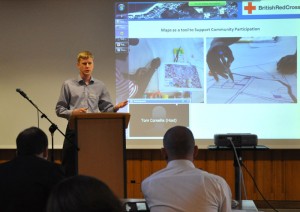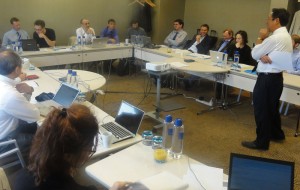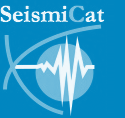Consulting Services
ImageCat is globally known for providing solutions and consulting services in the following areas:
Disaster Risk Assessment, Modeling and Management
 ImageCat’s engineers and scientists have many years of experience in performing natural hazard loss estimation studies. The principals are known internationally for their efforts in developing real-time loss estimation and risk assessment tools. Having served as principal investigators on numerous research contracts and grants, we have first-hand knowledge of the issues that government agencies face after devastating natural disasters. We generally approach problems of natural hazard risk assessment by separating the analysis into four main components. The first component deals with an assessment of the likelihood and severity of the hazard.
ImageCat’s engineers and scientists have many years of experience in performing natural hazard loss estimation studies. The principals are known internationally for their efforts in developing real-time loss estimation and risk assessment tools. Having served as principal investigators on numerous research contracts and grants, we have first-hand knowledge of the issues that government agencies face after devastating natural disasters. We generally approach problems of natural hazard risk assessment by separating the analysis into four main components. The first component deals with an assessment of the likelihood and severity of the hazard.
For most hazards, this requires establishing the proper metric for measuring hazard intensity and developing a hazard-frequency curve that specifies how likely the hazard will occur over some time period. The next component is a damage or fragility curve. Usually described in terms of a model, this component allows us to correlate damage levels to different levels of intensity. The third component is an exposure model. Depending on the focus of the analysis, this model may describe – in quantitative terms – the number of buildings or the extent of the population exposed to the hazard. For many of our studies, we will use remote sensing technologies to create these models. Finally, the last component deals with how the previous components are linked together. ImageCat has extensive experience in building integrated models that produce output that decision-makers can use to form hazard mitigation policies or strategies or assess current levels of risk.
Our engineers have developed seismic models for US risks as well as numerous web-GIS portals for clients. As Associate members we are currently working with the technical team of the OASIS Open Loss Modeling Framework to have more open access to our model solutions and software. Our preferred development cycle involves continuous consultation with the client throughout development to make sure the system is fit-for-purpose. This means rapid prototyping and regular release of system features, followed by a feedback and reconfiguring session. We have found this agile approach allows early feasibility assessment and prototypes that are modified based on a user feedback process. This is especially advantageous when working with a diverse and distributed user-base.
GIS and Remote Sensing
ImageCat is a worldwide leader is “fusing” remotely-sensed data with GIS technologies for the purpose of assessing risks from natural hazards. Our analysis usually begins by compiling a list of imagery available for the analysis or actually working with data providers (satellite or airborne companies) to create new datasets. During the Haiti earthquake, for example, we collaborated with numerous satellite and airborne companies to provide high-resolution imagery to the World Bank/GFDRR in support of the Post-Disaster Needs Assessment.
This information was used to perform detailed building damage assessments of Port-au-Prince and surrounding areas. One of the highlights of this analysis was the use of “crowd-sourcing” to engage a “crowd” of expert engineers and scientists to help with the damage assessment. Over 600 experts from 23 countries participated in this first-of-a-kind initiative; this effort was highlighted at the 2010 World Bank Understanding Risk conference and in numerous publications since. The distributed nature of crowd-sourcing has also seen it being used for post-hurricane deployments on behalf of FEMA (2012 Hurricanes Isaac and Sandy). The outputs of these expert-generated datasets are a set of openly distributed GIS maps and databases, delivered as web mapping services in a series of open and commercial web-GIS platforms.
ImageCat scientists led the Global Earthquake Model’s Risk Global Component, Inventory Data Capture Tools . In this three year project, a set of protocol documents was produced and thoroughly tested for open-source GIS and remote sensing data processing. These guides focused on Quantum GIS/GRASS suites of software and allow users to generate exposure data, including individual building footprints and areas of inter-urban homogeneous land use.
Open data and Software
 ImageCat supports and has been widely involved in many open data initiatives to date. Much of the post-event damage databases and map products developed have been in collaboration with national governments and multi-lateral agencies (i.e. the 2010 Haiti and Chile earthquakes, 2011 Japan tsunami, 2012 US hurricanes, tornadoes and floods, 2013 Oklahoma tornado). These data are produced in a systematic way and delivered to clients with full attribution of metadata allowing public sharing of the data on web-GIS portals and data repositories.
ImageCat supports and has been widely involved in many open data initiatives to date. Much of the post-event damage databases and map products developed have been in collaboration with national governments and multi-lateral agencies (i.e. the 2010 Haiti and Chile earthquakes, 2011 Japan tsunami, 2012 US hurricanes, tornadoes and floods, 2013 Oklahoma tornado). These data are produced in a systematic way and delivered to clients with full attribution of metadata allowing public sharing of the data on web-GIS portals and data repositories.
Open data access and sharing was the purpose of the Virtual Disaster Viewer platform founded by ImageCat, the Earthquake Engineering Research Institute (EERI) and the Multidisciplinary Centre for Earthquake Engineering Research (MCEER). The web-GIS portal allowed sharing of satellite imagery interpretations of damage following nine major disaster events alongside GPS-referenced in-situ field photographs. This platform was used to prepare teams for post-event field missions for EERI and the UK Earthquake Engineering Field Investigation Team (EEFIT) in locations as varied as L’Aquila, Italy, or Samoa.
Engineering Consulting Services
ImageCat provides engineering consulting services in:
- structural review and earthquake risk assessment for individual buildings and portfolios
- lifeline and utility vulnerability and risk from natural hazards
- natural hazard and technological hazard exposure screening
Much of our consulting practice makes use of the SeismiCat seismic risk management system (seismicat.com).
Recent Projects – Recent seismic risk analysis projects include have examined seaport wharfs and cranes (at the Port of Long Beach and Port of Seattle), airport and wharf facilities (Port of Portland); and a nationwide portfolio of rooftop and commercial photovoltaic panels. Previous seismic risk analysis projects have included new combined cycle natural gas electric power stations in northern and southern California, and the development of damage relationships for lifeline utility structures for the combined effects of earthquake shaking and tsunami inundation.
Solution Partners – ImageCat teams with a large number of engineering firms to provide flexible and innovative solutions to a wide-range of natural and technological hazards. We recently inaugurated the earthquake Risk Solution Marketplace (seismicat.com/index/market) where building owners, lenders and insurers can find qualified Structural Engineers, Geotechnical Engineers and wind risk specialists to do risk studies using the SeismiCat system.
An ASCE 41-13 Bridge to HAZUS Damage Models – ASCE 41-13 is the national standard for the seismic evaluation of existing buildings. The HAZUS earthquake model for buildings provides a framework for seismic risk assessment, addressing life-safety, economic losses for the building and its contents, and expected downtimes for repair and restoration. ImageCat is developing a new system intended to adjust HAZUS building damage models to reflect the engineering findings from building evaluations using ASCE 41-13. Professional Engineers can use this “bridge” as a tool for building seismic ratings, and to provide improved risk services for real estate owners, lenders, insurers and public agencies.
Urban Risk – ImageCat is exploring new models of seismic risk in the dense urban core (topplingtower.com). Here, older tall buildings with poor earthquake systems present high risks in large earthquakes. Towers that topple in side-sway can impact neighboring buildings, with increased economic and life-safety consequences. Current approaches in seismic design for new buildings, and proposed earthquake ratings systems for existing buildings, consider each building individually, without interaction with its neighbors. Yet impacts to surrounding structures are inevitable with the collapse of closely-spaced tall buildings, and a different, more complete picture emerges when the urban core is viewed in its complex 3D totality.
Robust Risk – ImageCat is developing a new “robust” model for seismic hazards, based on the 2014 USGS National Seismic Hazard Mapping Project models [Petersen et al.], but preserving the epistemic uncertainties that can be obscured by the use of logic trees. As a result, a more complete picture of the uncertainty of seismic ground shaking hazards emerges. When coupled with robust inventory and robust damage models, we will offer a complete robust seismic risk solution.

 562 628 1675
562 628 1675 

